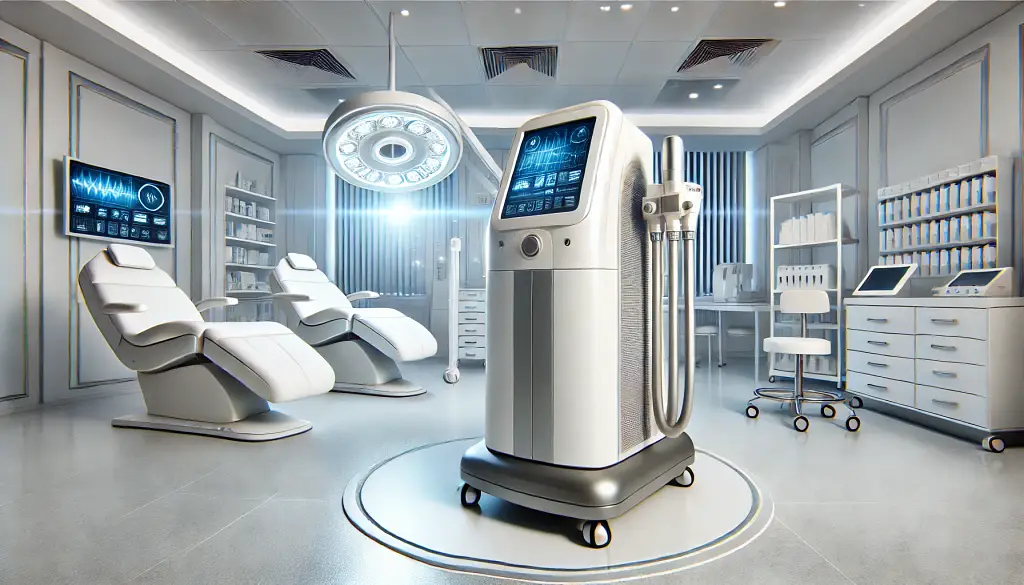Introduction
Laser Cooling in Dermatology has become an essential component of modern laser-based skin treatments. As dermatological lasers are widely used for procedures like hair removal, acne scar reduction, pigmentation correction, and skin rejuvenation, managing the heat generated during these treatments is critical. Laser cooling technology ensures that the epidermis remains protected from thermal damage while allowing effective energy delivery to deeper skin layers. This process not only enhances patient comfort but also enables dermatologists to use higher laser intensities for better results. With advanced cooling techniques such as contact cooling, cryogen spray, air cooling, and water chillers, laser procedures are now safer, faster, and more effective for a wide range of skin types and conditions. In short, laser cooling in dermatology is the perfect blend of safety and performance in aesthetic medicine.
Types of Cooling Methods in Dermatology Lasers
Each cooling method offers a unique mechanism of action, with specific advantages depending on the treatment type and skin sensitivity.
Contact Cooling
- Utilizes a sapphire or quartz window, usually integrated into the laser handpiece.
- This cooling element is in direct contact with the skin, transferring cold from the window to the epidermis.
- Continuous or pulsed cooling modes are available for various applications.
- Highly efficient in reducing epidermal damage, it also helps in compressing blood vessels, reducing absorption by hemoglobin in some treatments.
- Commonly used in diode lasers for hair removal, Nd:YAG lasers for vascular treatments, and fractional resurfacing lasers.
Cryogen Spray Cooling (CSC)
- Employs a brief spray of a cryogenic substance, usually tetrafluoroethane (R-134a), which evaporates instantly and absorbs surface heat.
- The spray is released milliseconds before the laser pulse, cooling only the epidermis while keeping the deeper layers unaffected.
- Offers a very fast and localized cooling effect, with high precision and little waste.
- Especially beneficial for patients with darker skin types, where there is a higher risk of thermal damage.
- Widely used with pulsed dye lasers (PDL) and alexandrite lasers for vascular and pigmentation treatments.
Air Cooling (Cold Air Devices)
- Uses a blower system to deliver a continuous stream of chilled air, typically at temperatures as low as -30°C, onto the skin.
- The cooling occurs before, during, and after the laser pulse, providing consistent comfort.
- Non-contact method: hygienic and reduces the risk of cross-contamination.
- Excellent for large treatment areas like back or legs in hair removal or tattoo removal.
- Portable, user-friendly, and adjustable in airflow intensity for customizable comfort.
Water-Based Chillers / Circulating Coolants
- These are external cooling systems where chilled water or glycol is circulated through a hose or flexible pad placed over the treatment area.
- The pad maintains a constant low temperature and is especially helpful in pre-cooling and post-cooling stages.
- Often integrated with IPL (Intense Pulsed Light) systems or used separately for post-procedure soothing.
- Ideal for sensitive skin areas or long-duration treatments that require steady thermal management.
Benefits of Laser Cooling in Dermatology
Each method brings significant value to both the patient and the practitioner. Here’s how:
Enhanced Patient Comfort
- Cooling greatly reduces the stinging and burning sensations typically felt during laser procedures.
- In many cases, it eliminates the need for topical anesthetics or numbing creams, making sessions quicker and more convenient.
Minimized Risk of Burns and Thermal Injury
- By protecting the epidermis (outermost skin layer), cooling prevents blistering, crusting, and long-term pigmentation issues.
- It ensures a safer experience for all skin types, especially darker tones prone to post-laser pigmentation.
Enables Higher Laser Intensities
- With surface cooling, dermatologists can safely increase energy levels of the laser to achieve deeper penetration and more effective results without causing surface burns.
- This leads to fewer sessions, saving time and cost for both doctor and patient.
Accelerates Post-Treatment Recovery
- Reduced inflammation and redness mean less downtime and faster healing.
- Helps patients return to daily activities with minimal disruption.
Improves Overall Clinical Outcomes
- Enhances treatment uniformity, precision, and depth of energy delivery.
- Allows better targeting of specific skin structures (melanin, hemoglobin, collagen, etc.) without affecting the skin’s integrity.
Conclusion
Laser Cooling in Dermatology plays a pivotal role in enhancing both the safety and success of laser skin treatments. By minimizing pain, preventing burns, and accelerating recovery, cooling systems significantly improve patient experience and clinical outcomes. Whether it’s a simple laser hair removal session or a complex skin resurfacing procedure, effective cooling ensures maximum comfort and minimal risk. As dermatology continues to evolve with cutting-edge technology, laser cooling remains a non-negotiable feature for any high-performance laser device. For clinics and professionals aiming to deliver superior care and results, investing in the right cooling solutions is not just beneficial—it’s essential.

